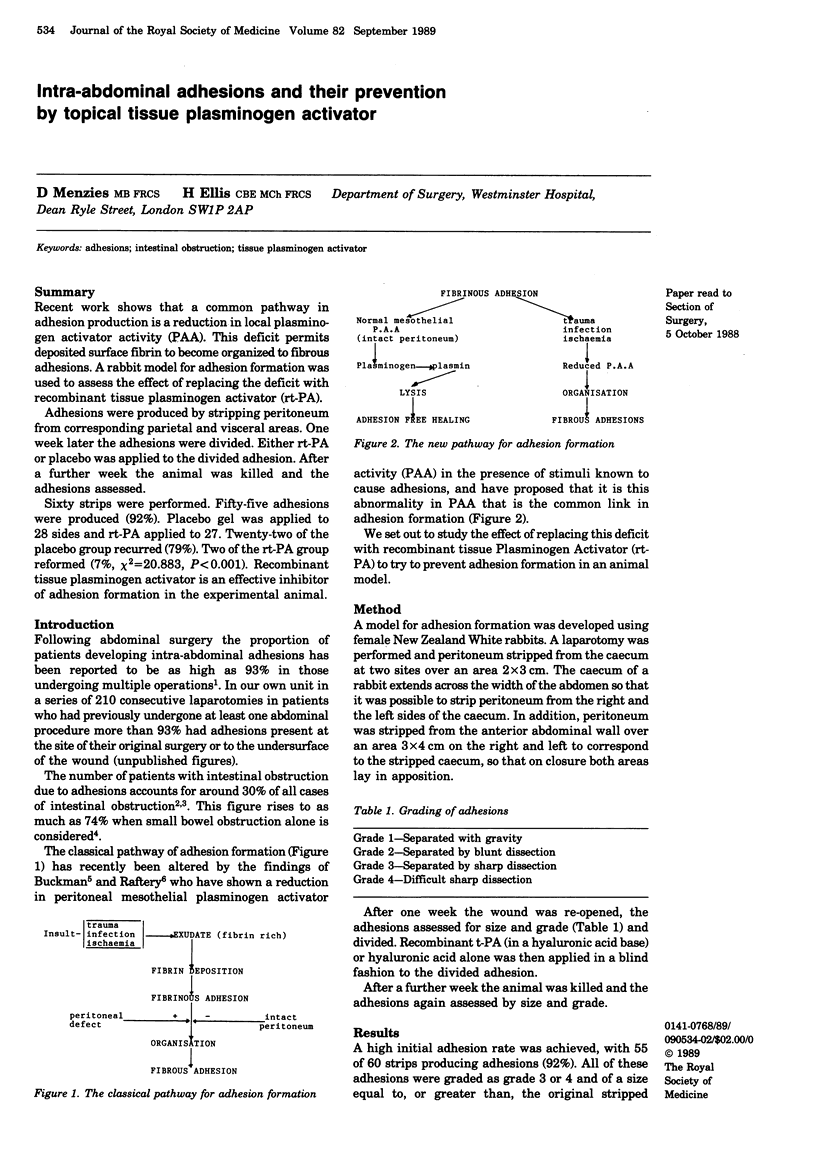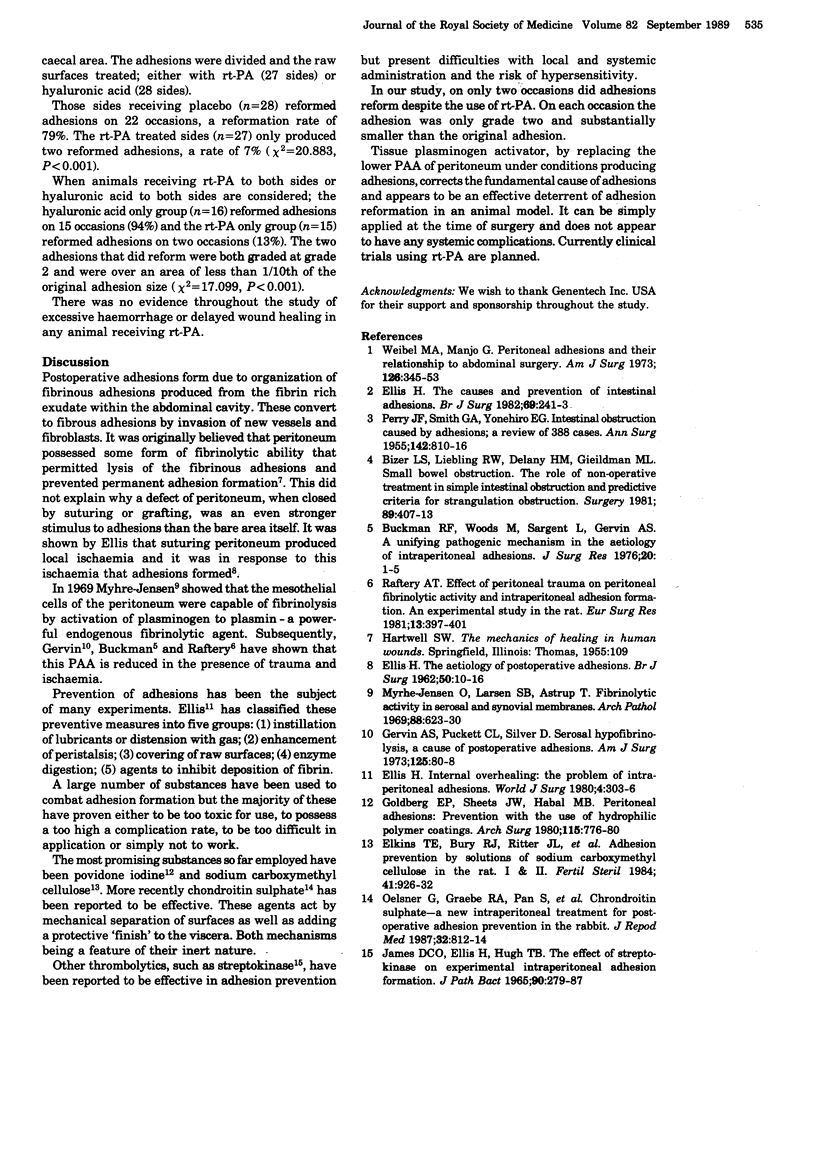Abstract
Recent work shows that a common pathway in adhesion production is a reduction in local plasminogen activator activity (PAA). This deficit permits deposited surface fibrin to become organized to fibrous adhesions. A rabbit model for adhesion formation was used to assess the effect of replacing the deficit with recombinant tissue plasminogen activator (rt-PA). Adhesions were produced by stripping peritoneum from corresponding parietal and visceral areas. One week later the adhesions were divided. Either rt-PA or placebo was applied to the divided adhesion. After a further week the animal was killed and the adhesions assessed. Sixty strips were performed. Fifty-five adhesions were produced (92%). Placebo gel was applied to 28 sides and rt-PA applied to 27. Twenty-two of the placebo group recurred (79%). Two of the rt-PA group reformed (7%, chi 2 = 20.883, P less than 0.001). Recombinant tissue plasminogen activator is an effective inhibitor of adhesion formation in the experimental animal.
Full text
PDF

Selected References
These references are in PubMed. This may not be the complete list of references from this article.
- Bizer L. S., Liebling R. W., Delany H. M., Gliedman M. L. Small bowel obstruction: the role of nonoperative treatment in simple intestinal obstruction and predictive criteria for strangulation obstruction. Surgery. 1981 Apr;89(4):407–413. [PubMed] [Google Scholar]
- Buckman R. F., Woods M., Sargent L., Gervin A. S. A unifying pathogenetic mechanism in the etiology of intraperitoneal adhesions;. J Surg Res. 1976 Jan;20(1):1–5. doi: 10.1016/0022-4804(76)90075-5. [DOI] [PubMed] [Google Scholar]
- ELLIS H. The aetiology of post-operative abdominal adhesions. An experimental study. Br J Surg. 1962 Jul;50:10–16. doi: 10.1002/bjs.18005021904. [DOI] [PubMed] [Google Scholar]
- Elkins T. E., Bury R. J., Ritter J. L., Ling F. W., Ahokas R. A., Homsey C. A., Malinak L. R. Adhesion prevention by solutions of sodium carboxymethylcellulose in the rat. I. Fertil Steril. 1984 Jun;41(6):926–928. doi: 10.1016/s0015-0282(16)47909-4. [DOI] [PubMed] [Google Scholar]
- Ellis H. Internal overhealing: the problem of intraperitoneal adhesions. World J Surg. 1980 May;4(3):303–306. doi: 10.1007/BF02393386. [DOI] [PubMed] [Google Scholar]
- Ellis H. The causes and prevention of intestinal adhesions. Br J Surg. 1982 May;69(5):241–243. doi: 10.1002/bjs.1800690502. [DOI] [PubMed] [Google Scholar]
- Gervin A. S., Puckett C. L., Silver D. Serosal hypofibrinolysis. A cause of postoperative adhesions. Am J Surg. 1973 Jan;125(1):80–88. doi: 10.1016/0002-9610(73)90011-1. [DOI] [PubMed] [Google Scholar]
- Goldberg E. P., Sheets J. W., Habal M. B. Peritoneal adhesions: prevention with the use of hydrophilic polymer coatings. Arch Surg. 1980 Jun;115(6):776–780. doi: 10.1001/archsurg.1980.01380060074022. [DOI] [PubMed] [Google Scholar]
- James D. C., Ellis H., Hugh T. B. The effect of streptokinase on experimental intraperitoneal adhesion formation. J Pathol Bacteriol. 1965 Jul;90(1):279–287. doi: 10.1002/path.1700900132. [DOI] [PubMed] [Google Scholar]
- Myrhe-Jensen O., Larsen S. B., Astrup T. Fibrinolytic activity in serosal and synovial membranes. Rats, guinea pigs, and rabbits. Arch Pathol. 1969 Dec;88(6):623–630. [PubMed] [Google Scholar]
- Oelsner G., Graebe R. A., Pan S. B., Haseltine F. P., Barnea E. R., Fakih H., DeCherney A. H. Chondroitin sulphate. A new intraperitoneal treatment for postoperative adhesion prevention in the rabbit. J Reprod Med. 1987 Nov;32(11):812–814. [PubMed] [Google Scholar]
- PERRY J. F., Jr, SMITH G. A., YONEHIRO E. G. Intestinal obstruction caused by adhesions; a review of 388 cases. Ann Surg. 1955 Nov;142(5):810–816. doi: 10.1097/00000658-195511000-00006. [DOI] [PMC free article] [PubMed] [Google Scholar]
- Raftery A. T. Effect of peritoneal trauma on peritoneal fibrinolytic activity and intraperitoneal adhesion formation. An experimental study in the rat. Eur Surg Res. 1981;13(6):397–401. doi: 10.1159/000128208. [DOI] [PubMed] [Google Scholar]
- Weibel M. A., Majno G. Peritoneal adhesions and their relation to abdominal surgery. A postmortem study. Am J Surg. 1973 Sep;126(3):345–353. doi: 10.1016/s0002-9610(73)80123-0. [DOI] [PubMed] [Google Scholar]


